The Intel Broadwell Xeon E3 v4 Review: 95W, 65W and 35W with eDRAM
by Ian Cutress on August 26, 2015 9:00 AM ESTIntel Broadwell Xeon E3 v4 Conclusions
If you skipped to the end without looking at the benchmark data, we’re going to throw a few graphs in here for good measure.
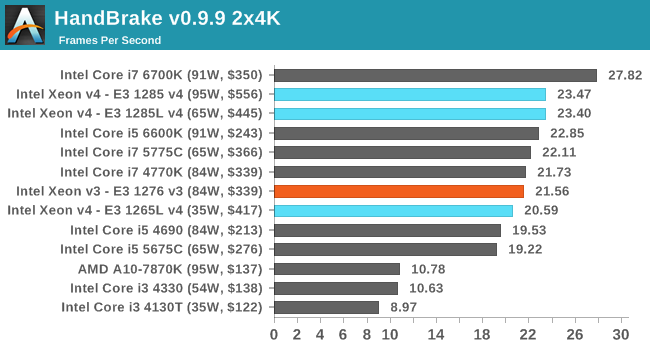
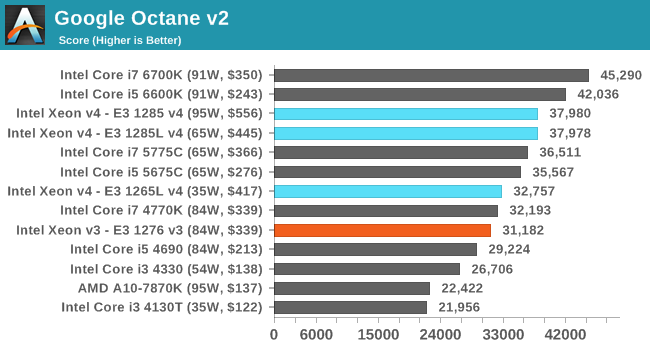
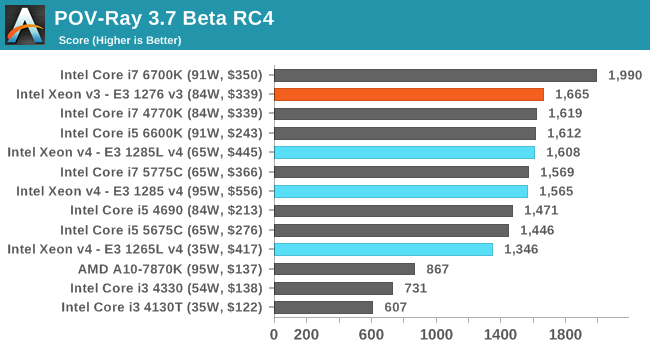
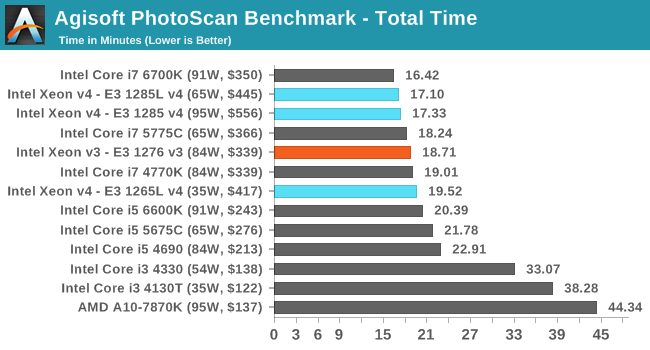
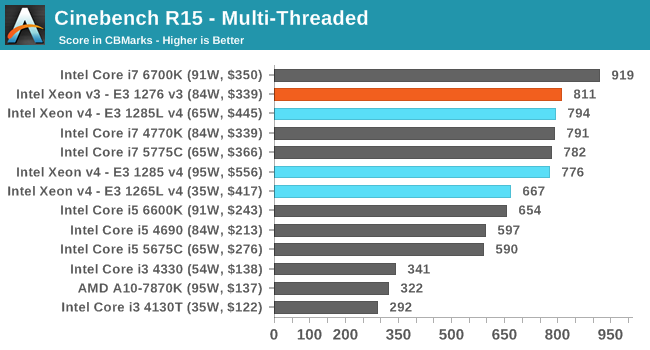
We said at the start of this review that one of the key parts to examine was the main parallel to the 95W of the E3-1285 v4 and the E3-1276 v3 at 84W due to their near similar (but not ideal) thermal design power metrics. The differentiator here is that the E3 v3 has some extra frequency, but the E3 v4 range has eDRAM.
At least, we thought this should be the battle to be had, but it is clear from the results that something else is more interesting. Comparing the E3-1285 v4 at 95W to its lower power variant, the E3-1285L v4 at 65W, we see that the low power variant scores better on almost all benchmarks.
The only difference between these two processors aside from the 30W of TDP should be the 100 MHz gap in favor of the 95W part. We said at the beginning that this 100 MHz does not adequately explain 30W in the grand scheme of things, so the lower powered model must also have a substantially better voltage/frequency profile. This, as it happens, has some knock on side effects.
In a couple of CPU tests, the extra frequency wins. This boils down to only 3DPM and Sunspider, both tests that arguably are neither extensively pressing the processor nor exhaustive in their capabilities. But the lower power model, by virtue of the better binning, is able to keep its higher frequency turbo mode available for 100% of the time in our testing, ultimately giving a higher frequency and completing work quicker. This is despite the base frequency of the E3-1285 v4 being higher, and alluding to a variable turbo frequency profile based on power draw. To cap it off, the E3-1285L v4 is also $111 cheaper. So when the two processors are put side-by-side, the decision is obvious. We would choose the E3-1285L v4 every time.
This means the title fight should be between the 65W E3-1285L v4 and the E3-1276 v3 at 84W. Here it gets a little more edgy – the v4 here is technically 100 MHz above the i7-5775C which we looked at in our last Broadwell review, and we get more into a performance/power based efficiency discussion based on the TDP difference than the 95W vs 84W discussion.
In DRAM heavy scenarios such as WinRAR, which requires a large amount of cache to retain dictionary compression tables, the benefits of the eDRAM are easy to see. Benchmarks on the integrated graphics also win out due to the Iris Pro P6300. For discrete graphics, the Broadwell parts certain win over the v3 for efficiency at this point, with results between the two being almost identical. But the big one to note here is Photoscan in pure CPU mode, where Broadwell takes a minor lead – Photoscan uses a set of fifty two-dimensional photos with no depth information to create a three-dimensional imagine over several stages, so managing that data around the memory subsystem becomes a handful when there are 40,000 data points per picture in flight. This benchmark was suggested to us by an archivist at a national library who uses it to recreate models of the artifacts in their storage for external examination.
For all the other CPU tests, a dichotomy appears. The higher frequency v3 wins for compute driven performance, but data driven metrics (and efficiency) are the realm of Broadwell, Xeon or otherwise, as long as there is frequency to match.
As mentioned on the first page of the review, on the suggestion of a number of our readers and based on these interesting, we are looking into other avenues which are also data driven. Previously our Chrome compilation benchmark was a featured set piece in our testing, but has fallen away and a similar equivalent needs to be reintroduced. As a result, we are speaking to some users and looking into a series of tests of this nature that afford a repeatable and consistent point of analysis – ideally in an automated context if possible and encompassing a variety of projects and languages. At current there is no time framework for introduction, but September affords some time to focus on the project and then test a number of processors on it. Thoughts and suggestions should be forwarded to ian@anandtech.com.


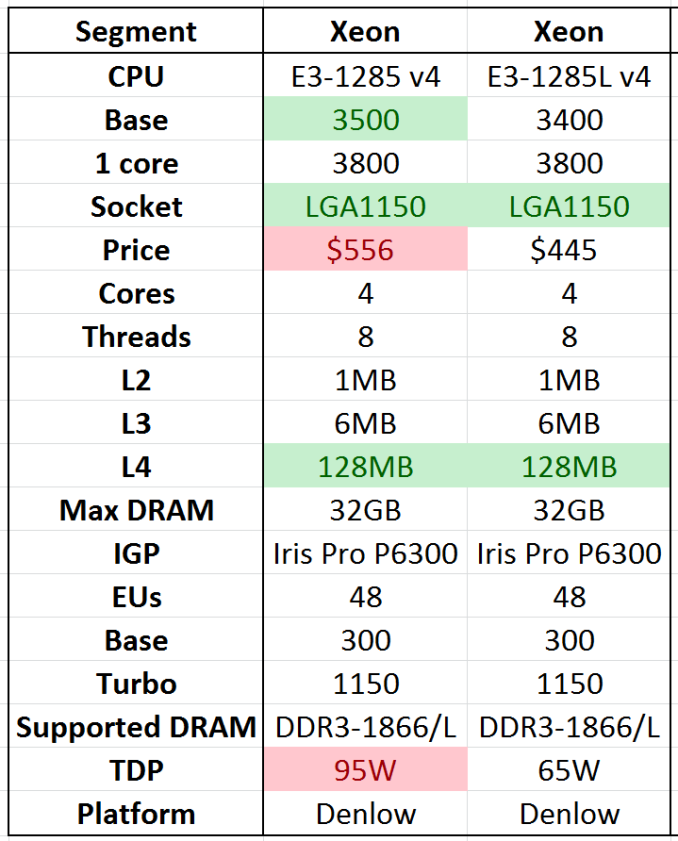
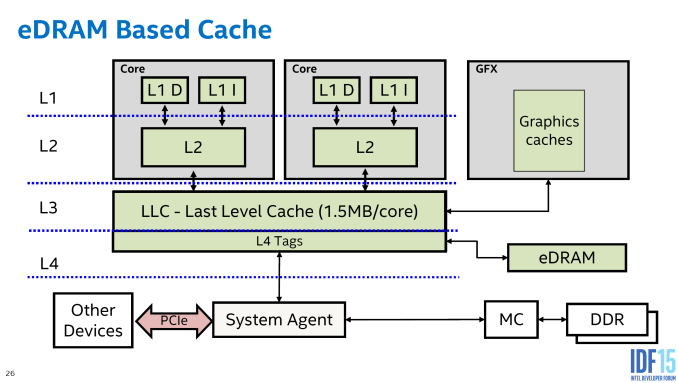








72 Comments
View All Comments
runciterassociates - Wednesday, August 26, 2015 - link
This is a server chip. Why are you benchmarking games?Furthermore, for SPEC, why are you using a dGPU when this chip has on die graphics?
Where are the OpenCL, OpenMP, GPGPU benchmarks, which are going to be the majority of how these will be used for green heterogeneous computing?
Gigaplex - Wednesday, August 26, 2015 - link
The E3 Xeons are more likely to be used in a workstation than a server.TallestJon96 - Wednesday, August 26, 2015 - link
They benchmark games because ignorant gamers (like myself) love to see gaming benchmarks for everything, even if they will never be used for games! If it was a 20 core Xeon clocked at 2ghz with hyper threading, we would want the benchmarks, even though they just show that everything i5 and up performs identically. We are a strange species, and you should not waste your time trying to understand us.Oxford Guy - Wednesday, August 26, 2015 - link
No benchmarks are irrelevant when they involve products people are using today. Gaming benchmarks are practical. However, that doesn't mean charts are necessarily well-considered, such as with how this site refuses to include a 4.5 GHz FX chip (or any FX chip) and instead only includes weaker APUs.Ian Cutress - Thursday, August 27, 2015 - link
As listed in a couple of sections of the review, this is because Broadwell-H on the desktop does not have an equivalent 84W part for previous generations and this allows us, perhaps somewhat academically, so see if there ends up being a gaming difference between Broadwell and Haswell at the higher power consumption levels.Jaybus - Friday, August 28, 2015 - link
Because, as stated in the article, the Ubuntu Live CD kernel was a fail for these new processors, so they couldn't run the Linux stuff.Voldenuit - Wednesday, August 26, 2015 - link
SPECviewperf on a desktop card?I'd be interested to see if a Quadro or FirePro would open up the gap between the CPUs.
mapesdhs - Thursday, August 27, 2015 - link
I was wondering that too; desktop cards get high numbers for Viewperf 12 because they cheat in the driver layer on image quality. SPEC testing should be done with pro cards where the relevance is more sensible. The situation is worse now because both GPU makers have fiddled with their drivers to be more relevant to consumer cards. Contrast how Viewperf 12 behaves with desktop cards to the performance spread observed with Viewperf 11, the differences are enormous.For example, tesing a 980 vs. a Quadro k5000 with Viewperf 11 and 12, the 980 is 3X faster than the K5000 for Viewperf 12, whereas the K5000 is 6x faster than the 980 for Viewperf 11. More than an order of magnitude performance shift just by using the newer test suite?? I have been told by tech site people elsewhere that the reason is changes to drivers and the use of much less image quality on consumer cards. Either way, it makes a nonsense of the usefulness of Viewperf if this is what's going on now. Otherwise, someone has to explain why the 980 compares so differently to a K5000 for Viewperf 11.
Ian Cutress - Thursday, August 27, 2015 - link
Both points noted. I'll see what I can do to obtain the professional cards.XZerg - Wednesday, August 26, 2015 - link
The gaming charts are messed up - igp performs faster than the dgpu on the SAME settings? i think something is wrong - most likely the labels of settings.Also it would have been better to compare IGP performance against the older versions of IRIS - where is 4770R? the point here is that while keeping the W similar, what are we really getting out of 14nm?